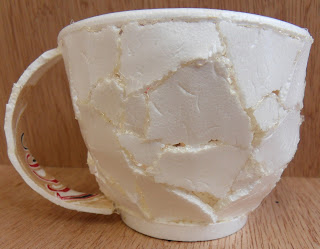Duchamp's work raises doubts about aesthetic judgments questioning audience perception of art itself. I too am interested in perception and receipt of the visual language of objects, with an alternative focus on the social ritual attached to my object (the tea cup). Duchamp originally drew inspiration from the cubist idea of simultaneous different perspectives, which i think ties into my exploration of the meaning of a cup of tea to individuals, cultures and social groups/families. The coding of the object simultaneously describes the function, form and symbolism.
'Duchamp kept the focal point of meaning of his work deliberately vague, and invited the beholder/reader to take part in what are ultimately inconcludable reflections on the meaning of the work.'
Taking the words that i spelled out inside my tea cup in 'You're My Cup Of Tea', from the spider diagram contributed to by a number of anonymous volunteers; I have invited my audience to reflect upon the meaning of the object thus exploring the meaning of the work before it was even created. This theme of interactive art and audience participation is consistent throughout the short film. Whilst being recorded, my volunteers experience my object from their individual perspective and reflect upon it by writing their chosen word into the tea leaves (also adding the experience of a foreign perspective of the physicality of the tea as a material).
The art is the ideas and perceptions drawn from the receipt of the object. When it comes to objects, our perceptions are the understanding of a preconceived coding subject to the experience of the individual...and so I ask myself: Is this artwork mine? It has my name on it, but consists of an exploration of other peoples reflections. It only makes sense that Duchamp signed his most famous work 'Fountain': R.Mutt.
Marcel Duchamp's 'Fountain' lead me to consider the status of an object in its own right. Duchamp described the use of inanimate objects as:
'the simple idea of interrupting the use-flow of everyday things.'
Does a Tea Cup carry the same connotations as it does on a coffee table when in an altered context or environment?
What if the tea cup was no longer a tea cup?
Altered form and functionality = altered meaning.
Does a Tea Cup carry the same connotations as it does on a coffee table when in an altered context or environment?
What if the tea cup was no longer a tea cup?
Altered form and functionality = altered meaning.
"It's the viewers which make the pictures."
(Marcel Duchamp)
(Marcel Duchamp)
Marzona, D. (2006) Conceptual Art.USA-Los Angeles:Taschen.
beautiful objects post.





No comments:
Post a Comment